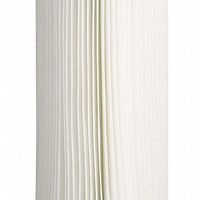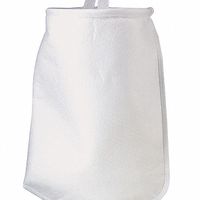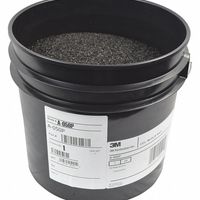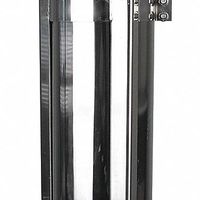Call +(254) 703 030 000 / 751 483 999 / 721 704 777
- Home
- Plumbing
- Water Filtration Purification Systems
- Process Water Filter Systems
Frequently Asked Questions
What are the benefits of using process water filter systems?
Process water filter systems offer numerous benefits across various industries. Firstly, they enhance product quality by removing impurities, ensuring that the water used in manufacturing processes is clean and consistent. This is crucial in industries like food and beverage, pharmaceuticals, and electronics, where water purity directly impacts product integrity.
Secondly, these systems improve operational efficiency. By filtering out contaminants, they prevent equipment fouling and scaling, reducing maintenance costs and downtime. This leads to longer equipment lifespan and more reliable production schedules.
Thirdly, process water filters contribute to environmental sustainability. They enable water recycling and reuse, reducing the overall water consumption and minimizing the environmental footprint of industrial operations. This is increasingly important as industries face stricter environmental regulations and seek to adopt more sustainable practices.
Additionally, using process water filters can lead to cost savings. By improving water quality, they reduce the need for chemical treatments and lower energy consumption associated with heating or cooling processes. This results in decreased operational costs over time.
Moreover, these systems enhance workplace safety. By ensuring that water used in processes is free from harmful contaminants, they protect workers from potential health hazards associated with exposure to polluted water.
Finally, process water filter systems can improve compliance with industry standards and regulations. By providing consistent water quality, they help companies meet stringent quality control requirements and avoid potential legal and financial penalties associated with non-compliance.
In summary, process water filter systems offer benefits such as improved product quality, operational efficiency, environmental sustainability, cost savings, workplace safety, and regulatory compliance, making them a valuable investment for industries reliant on high-quality water.
How do filter bags and filter cartridges work in reducing contaminants?
Filter bags and filter cartridges are essential components in filtration systems, designed to remove contaminants from liquids or gases.
Filter bags are typically made from materials like felt, nylon, or polypropylene. They work by allowing the fluid to pass through while trapping larger particles within the bag. The filtration process is primarily mechanical, relying on the size of the pores in the bag material to block contaminants. As the fluid flows through, particles larger than the pore size are retained, effectively reducing the contaminant load. The bags can be used in various applications, including water treatment, chemical processing, and food and beverage production. They are easy to replace and can handle high flow rates, making them suitable for bulk filtration.
Filter cartridges, on the other hand, are cylindrical filters made from materials such as pleated paper, polypropylene, or activated carbon. They offer a more refined filtration process, often incorporating multiple layers to capture different sizes of particles. Cartridges can provide depth filtration, where contaminants are trapped throughout the thickness of the filter medium, or surface filtration, where particles are captured on the surface. Some cartridges also use adsorption, particularly those with activated carbon, to remove dissolved substances and odors. Cartridges are commonly used in applications requiring higher purity levels, such as pharmaceuticals, electronics manufacturing, and drinking water purification.
Both filter bags and cartridges are selected based on factors like the type of contaminants, required flow rate, and desired level of filtration. They are integral to maintaining system efficiency, protecting equipment, and ensuring product quality by effectively reducing contaminants in various industrial and commercial processes.
What types of contaminants can process water filter systems remove?
Process water filter systems can remove a wide range of contaminants, including:
1. **Particulate Matter**: These systems can filter out suspended solids such as dirt, sand, silt, and clay, which can cause turbidity and affect the clarity of the water.
2. **Microorganisms**: They can eliminate bacteria, viruses, protozoa, and other pathogens that pose health risks, using methods like microfiltration, ultrafiltration, or UV treatment.
3. **Organic Compounds**: Filters can remove organic pollutants, including pesticides, herbicides, and industrial solvents, which can be harmful to both human health and the environment.
4. **Inorganic Compounds**: These systems can target inorganic contaminants such as heavy metals (lead, mercury, arsenic), nitrates, and phosphates, which can be toxic and contribute to water pollution.
5. **Chemical Contaminants**: Process water filters can remove residual chlorine, chloramines, and other disinfectant by-products that may be present in treated water.
6. **Dissolved Gases**: Some systems are designed to remove dissolved gases like carbon dioxide, hydrogen sulfide, and methane, which can affect water quality and taste.
7. **Minerals and Salts**: Through processes like reverse osmosis, these systems can reduce the concentration of dissolved minerals and salts, such as calcium and magnesium, which cause water hardness.
8. **Color and Odor**: Activated carbon filters and other specialized media can remove color and odor-causing compounds, improving the aesthetic quality of the water.
9. **Oil and Grease**: Certain filters are capable of removing oil and grease, which are common in industrial wastewater.
10. **Pharmaceuticals and Personal Care Products**: Advanced filtration technologies can target emerging contaminants like pharmaceuticals and personal care products that may be present in trace amounts.
These systems are tailored to specific applications, ensuring the removal of contaminants relevant to the intended use of the process water.
How do filter housings function in high-pressure and high-temperature conditions?
Filter housings in high-pressure and high-temperature conditions function by providing a robust and secure environment for the filtration process. They are designed to withstand extreme conditions through the following mechanisms:
1. **Material Selection**: Filter housings are constructed from materials like stainless steel, Inconel, or titanium, which have high tensile strength and excellent thermal resistance. These materials prevent deformation and maintain integrity under stress.
2. **Design Features**: The housings are engineered with thick walls and reinforced structures to handle high pressures. They often include features like ribbing or gussets to enhance strength and prevent collapse.
3. **Sealing Mechanisms**: High-quality gaskets and O-rings made from materials like PTFE or Viton are used to ensure a tight seal, preventing leaks even under fluctuating temperatures and pressures.
4. **Thermal Expansion Accommodation**: The design accounts for thermal expansion and contraction, ensuring that components fit together tightly without causing stress or misalignment.
5. **Pressure Relief Systems**: Safety features such as pressure relief valves are incorporated to release excess pressure, preventing potential damage or failure.
6. **Corrosion Resistance**: The materials and coatings used are resistant to corrosion, which is crucial in high-temperature environments where chemical reactions can be accelerated.
7. **Maintenance and Inspection**: Easy access for maintenance and inspection is provided to ensure that the filter elements can be replaced or cleaned without compromising the housing's integrity.
8. **Testing and Certification**: These housings undergo rigorous testing and certification to meet industry standards, ensuring they can reliably perform under specified conditions.
By integrating these features, filter housings effectively manage the challenges posed by high-pressure and high-temperature environments, ensuring efficient filtration and system protection.
What is the role of loose filter media in automatic backwash filter systems?
In automatic backwash filter systems, loose filter media play a crucial role in the filtration process. These media, typically composed of materials like sand, anthracite, or garnet, are responsible for trapping and removing suspended particles, contaminants, and impurities from the fluid passing through the filter. The loose nature of the media allows for a high surface area, which enhances the filtration efficiency by providing numerous contact points for particles to adhere to.
During operation, the fluid flows through the filter media, and as it passes, particles are captured within the interstitial spaces between the media grains. This process effectively reduces turbidity and improves the clarity and quality of the filtered fluid. The choice of media type and size is critical, as it determines the filter's ability to capture different sizes and types of particles.
The automatic backwash feature is integral to maintaining the filter's performance and longevity. Over time, the accumulation of trapped particles can lead to increased pressure drop and reduced flow rates. The backwash process reverses the flow of fluid through the filter, agitating and loosening the media bed. This action dislodges the trapped particles, which are then flushed out of the system, restoring the filter's capacity and efficiency.
Loose filter media are essential for the self-cleaning mechanism of automatic backwash filters. Their ability to be easily agitated and rearranged during backwashing ensures that the media bed remains effective for repeated filtration cycles. This self-renewing capability minimizes maintenance requirements and operational downtime, making automatic backwash filter systems highly efficient and cost-effective for various industrial and municipal applications.
Where are process water filter systems commonly used?
Process water filter systems are commonly used in various industries to ensure the quality and safety of water used in production processes. These systems are essential in:
1. **Manufacturing**: In industries such as automotive, electronics, and textiles, process water filters remove impurities that could affect product quality or damage equipment.
2. **Food and Beverage**: Ensuring water purity is crucial for maintaining hygiene and taste standards. Filters remove contaminants that could spoil products or pose health risks.
3. **Pharmaceuticals**: High-purity water is essential for drug formulation and production. Filters eliminate particulates, bacteria, and other impurities to meet stringent regulatory standards.
4. **Chemical Processing**: Filters are used to remove solids and other impurities that could interfere with chemical reactions or contaminate products.
5. **Power Generation**: In power plants, especially those using steam turbines, water purity is critical to prevent scaling and corrosion. Filters help maintain the efficiency and longevity of equipment.
6. **Mining and Mineral Processing**: Water filters are used to treat process water, removing suspended solids and other contaminants to protect equipment and improve the efficiency of mineral recovery processes.
7. **Oil and Gas**: In both upstream and downstream operations, water filtration is used to remove particulates and other impurities from process water, protecting equipment and ensuring compliance with environmental regulations.
8. **Pulp and Paper**: Filters remove fibers, fillers, and other contaminants from process water, which is crucial for maintaining product quality and equipment performance.
9. **Textile Industry**: Water filters are used to remove dyes, chemicals, and other impurities from process water, ensuring consistent product quality and reducing environmental impact.
10. **Municipal Water Treatment**: While not strictly an industrial application, municipal water treatment facilities use process water filters to ensure the safety and quality of drinking water supplied to the public.
How do I choose the right process water filter system for my needs?
To choose the right process water filter system, first assess your specific water quality needs by identifying contaminants present, such as sediments, chemicals, or microorganisms. Conduct a water analysis to determine these impurities. Next, define the purpose of filtration, whether for industrial, commercial, or residential use, as this will influence the type and capacity of the system required.
Consider the flow rate and volume of water that needs to be filtered daily to ensure the system can handle your demand. Evaluate the available filtration technologies, such as activated carbon, reverse osmosis, UV purification, or sediment filters, and select one that effectively targets your specific contaminants.
Assess the installation space and infrastructure compatibility, ensuring the system fits within your existing setup and is easy to maintain. Factor in the cost of the system, including initial investment, operational expenses, and maintenance, to ensure it aligns with your budget.
Research the reliability and reputation of manufacturers and suppliers, opting for those with proven track records and positive customer reviews. Check for certifications and compliance with industry standards to ensure quality and safety.
Finally, consider the environmental impact of the system, such as energy consumption and waste production, and choose an eco-friendly option if possible. By thoroughly evaluating these factors, you can select a process water filter system that meets your specific needs efficiently and effectively.



